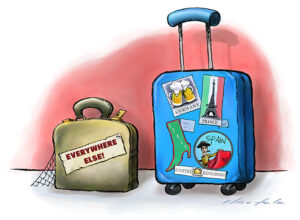I’m not sure when I first became obsessed with traveling to Europe. It was at an early age when I couldn’t have known much about it. But somehow Europe became the place I longed to go more than anywhere. Early on it settled in my imagination as a mythical, magical place of great wonder and pleasure.
I don’t know what set it off. I learned about England early on because my mother and grandparents had just come to America when I was born. Perhaps my fascination with Europe began when I heard them talking about England, and the longing in their voices when they spoke of the place they called home. I inherited their fondness for England before I had any idea of geography.
England is part of Europe – or not – depending on which day of the week. But to most people, it’s part of “The Continent.” That gets confusing.
In grade school I learned that Europe was a continent, though it didn’t fit the definition. We were told that a continent is a large body of land surrounded on all sides by ocean. Europe is a peninsula off Asia. But we call it a continent by tradition. Europe’s importance in the world has always been much greater than its physical size warrants.
That was only one of many contradictions I was told with a straight face during my education. But the larger point was made: Europe is exceptional. Even now, after decades of expanding my travel horizons, Europe still stands inordinately tall on the landscape of my imagination. As I look around, I see that I am not unusual in this. Europe is perennially the most popular tourist destination in the world.

There are many ways to interpret statistics, but certainly the top tourist destinations by visitors makes an irrefutable point about the popularity of Europe. I came upon this list of the top tourism destinations in 2019:
France – 90.0 million
Spain – 83.7 million
United States – 79.3 million
China – 65.7 million
Italy – 64.5 million
Turkey – 51.2 million
Mexico – 45.0 million
Thailand – 39.8 million
Germany – 39.6 million
United Kingdom – 39.4 million
Six of the top 10 countries are in Europe. If you compared in terms of land mass, or consider Europe as a single destination, the numbers would be even more lopsided.
Europe is about the same land area as the United States. But it packs all those countries of major importance into that space. And those countries have individual histories that date back thousands of years. It’s incomprehensibly rich in culture and history. Even before the wave of colonialism, Europe received a lot of influence from Asia via the ancient trade routes.
The European colonial powers spread their influence around the world, transplanting their cultures to the places where they established colonies, leaving deep imprints on Latin America, North America, Asia and Africa. But the colonized also influenced the colonizers. Aspects of the indigenous cultures flowed back to the imperial powers, catalyzing social changes.
When French sailors started taking wives in the French colony in Brazil, it set off waves of cultural exchange back in Europe that influenced Rousseau in his writings about “The Noble Savage.” The cultural cross-pollination enriched the cultures on both sides of the exchange, and led to unpredictable results.
Considering the spread of Europe via colonialism, and the scale of its contribution to world culture, Europe creates an inordinately large footprint on the world. Europe is Western Civilization, and it is still the dominant cultural influence around the world.
My Renaissance
I first looked at the word “Renaissance” as the name of a style of chess set in which the pieces look like statues of the king, queen, bishop, etc. Later I learned more about the great flourishing of culture that erupted around the 1400s in Italy.
The Renaissance pointed back to Classical Greece and Rome. So discovering the Renaissance meant also discovering those earlier times. From the Renaissance, which was also the beginning of the colonial period, all the modern history of the West flows.
I became enamored with the idea of “The Renaissance Man,” which meant someone who was multi-talented, who boldly set off to uncharted areas and created and discovered wonderful things that had never been dreamed of before. Leonardo da Vinci was the embodiment of the Renaissance Man, prodigiously talented and accomplished in a number of different fields of learning and art.
The art of the Renaissance alone would be more than enough to justify a trip to Europe. The paintings of da Vinci, the sculptures of Michelangelo and the frescoes on the ceiling of the Sistine Chapel, set off a revolution in the mind, a reflection of the effect they had on the world, expanding the boundaries of what was possible.
Traveling to Europe for me became the dividing line between those who lived dull lives and those who lived to the fullest extent. I remained sadly on the outside for a long time. I envied anyone who had traveled to Europe. Such a person assumed some sort of semi-divine status to me. “You traveled to Europe? Really? Wow! What was it like?” In my imagination it was like going to heaven.
Eventually I did get to Europe. I did discover the Renaissance in Florence. Over a period of years, I explored London, Paris, Rome, Athens, Vienna, and much more, but just a minute fraction of what is there.
The Renaissance was just a beginning to my learning about Europe. There were many smaller renaissances in different countries that produced flowerings of styles of art, architecture and music, the Flemish painters, the French Impressionists, the Baroque, Classical and Romantic composers, the great architects.
And there is the tumultuous epic of political and social history. The European history of the last century could be enough to consume one’s interests for a lifetime. The more I learn about Europe, the more I realize how much I am still missing.
When I first became possessed by the urge to travel, Europe was the embodiment of a uniquely rich travel destination. You can take a tour of Europe and pass through many different cultures in a small space.
Each country has its own character, distinct from the others. Italy is not like Spain, or Greece, and they are not like Germany or France, and they are not like England. France neighbors Spain, Italy, Germany, Austria and Britain. All different worlds.
It’s not surprising that so much cultural richness comes from Europe. All of those distinct cultures were so geographically close together that there was a tremendous amount of cultural cross-pollination among them.
When you think of European classical music, there is a fundamental kinship among the styles of music of the various cultures. Though they spoke different languages, the composers of various countries passed ideas back and forth using the common language of music.
With architecture it was the same. A German and a French architect may speak different languages, but they both understood the language of architecture. Culture spread throughout Europe unhindered by language barriers. Europe was a fertile cultural breeding ground.
Even as my appreciation for other regions grows, you can’t take it away from Europe. It remains the most popular travel destination in the world, and for good reason. Since my early days I’ve experienced much more exotic and far-flung places. But nothing ever diminishes the greatness of Europe. I still feel like I’ve only scratched the surface of it. I guess I’d better get busy. I’ve got a lot of ground to cover.
Your humble reporter,
Colin Treadwell





More Stories
Bar and Hotel Cleaning – Essential Equipment
Online Hotel Reservations Guide
Why Outsource Hotel Operations Management?